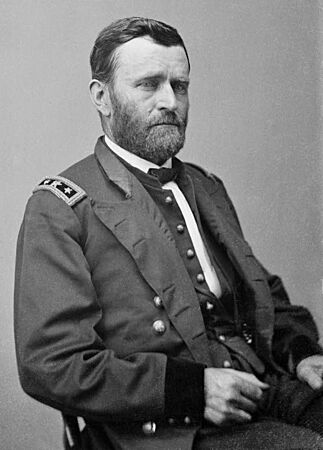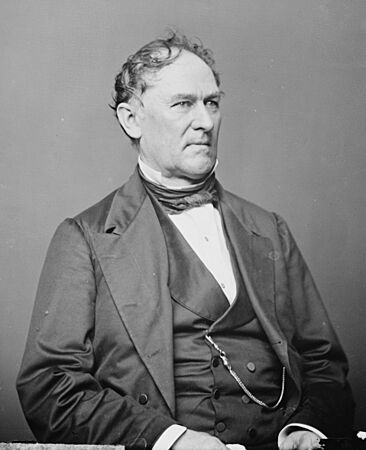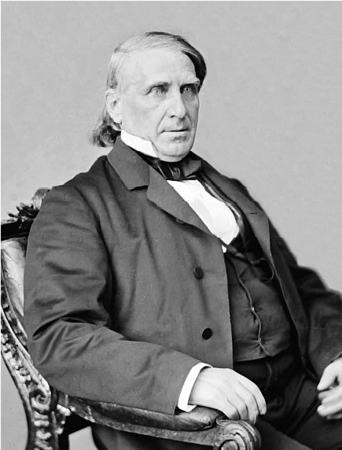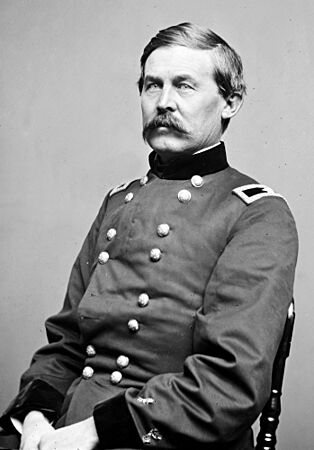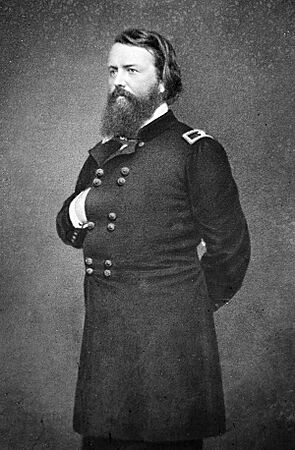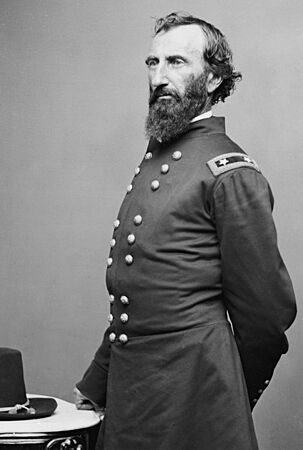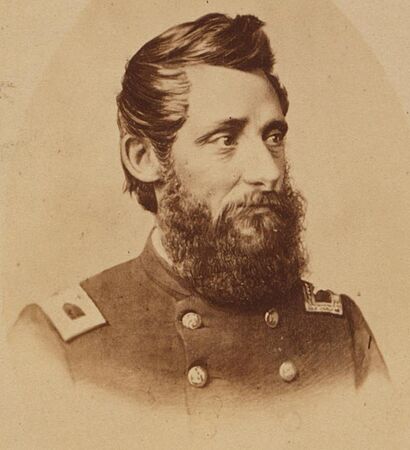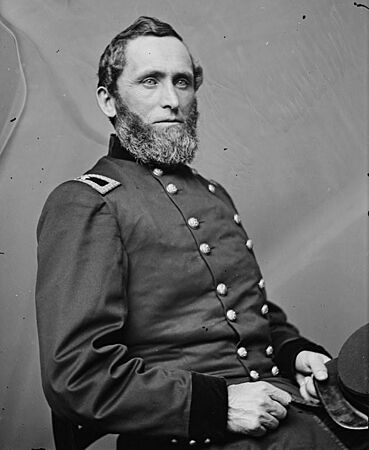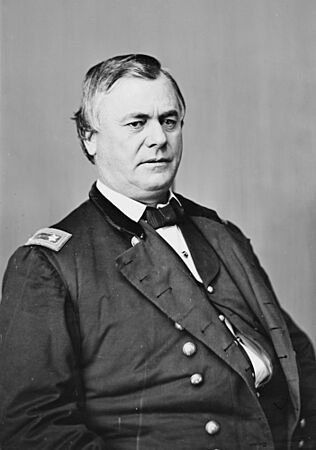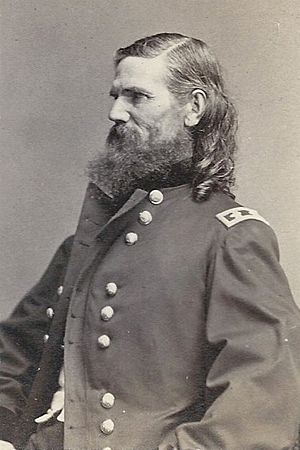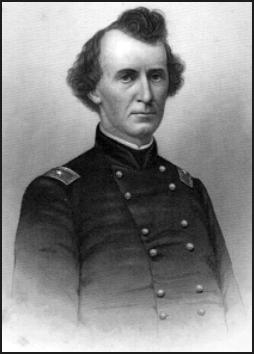Illinois in the American Civil War facts for kids
The state of Illinois during the American Civil War was very important for the Union Army. It provided many soldiers, especially for the armies fighting in the Western Theater of the Civil War. Illinois also supplied lots of military gear, food, and clothes. Because it was located near big rivers and railroads, Illinois became a key starting point early in the war. This helped Ulysses S. Grant try to take control of the Mississippi River and Tennessee Rivers. Most people in Illinois strongly supported the Union, even though some had different ideas.
Governor Richard Yates led Illinois with great energy throughout the war. Illinois sent 250,000 soldiers to the Union Army. This made it the fourth state with the most soldiers in the Federal military. Most Illinois troops fought in the Western Theater. However, a few regiments also played important roles in the East, especially in the Army of the Potomac. Thousands of Illinois soldiers died or were wounded during the war. Many national cemeteries were created in Illinois to bury them.
Besides President Abraham Lincoln, many other Illinois men became famous in the army or in national politics. These included generals like Ulysses S. Grant, John M. Schofield, and John A. Logan. Senator Lyman Trumbull and Representative Elihu P. Washburne were also important. No big battles happened in Illinois itself. But several river towns became important places for supplies and navy shipyards. After 1863, several prisoner of war camps were set up in the state. They held thousands of captured Confederate soldiers.
However, not everyone in Illinois supported the war. Some people in Southern Illinois, also called Little Egypt, even wanted to leave the United States. In Marion, residents voted to secede. A few people from the southern tip of the state even joined the Confederate States Army in Tennessee. About 34 to 45 men from Jackson and Williamson County joined a Confederate unit. This happened because the region had strong cultural and economic ties to the South. But the idea of leaving the Union soon faded away.
John A. Logan, a Democrat, represented eighteen counties in southern Illinois. In early 1861, there were rumors that he might join the Confederacy. But he actually stopped people who supported the Confederacy. He also organized his own supporters to fight for the Union. Lincoln made him a general, and Logan played a big role under generals Grant and Sherman. His soldiers started the war as Democrats and returned home as Republicans. Later, Logan helped start the Grand Army of the Republic veteran group. He was elected to the United States Senate as a Republican. He was also the Republican candidate for vice president in 1884. Union troops stayed in Little Egypt for the rest of the war as a safety measure. Some Confederate feelings remained in Southern Illinois as the Copperhead political movement grew in the North.
Contents
Illinois's Role in the War
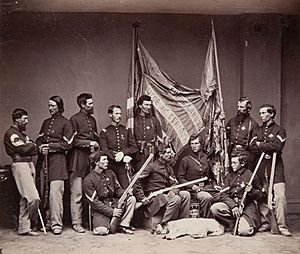
During the Civil War, 256,297 people from Illinois joined the Union army. This was more than any other northern state except New York, Pennsylvania, and Ohio. When President Lincoln first asked for troops, Illinois began sending soldiers. Throughout the war, the state formed 150 infantry regiments, from the 7th Illinois to the 156th Illinois. Seventeen cavalry regiments and two light artillery regiments were also formed.
People were very excited to join the army. Because of this, the military draft was not used much in Chicago and nearby areas. However, it did help get soldiers for Illinois regiments later in the war in other parts of the state.
Training and Prison Camps
Camp Douglas, near Chicago, was one of the largest training camps for Union troops. Camp Butler near Springfield was another important camp. Both also served as major prisoner-of-war camps for captured Confederates. Another big POW camp was at Rock Island. Thousands of Confederates died in these Illinois prison camps. They are buried in nearby cemeteries.
Important Supply Bases
No Civil War battles were fought in Illinois. But Cairo, where the Ohio River meets the Mississippi River, became a very important Union supply base. It was protected by Camp Defiance. Other major supply depots were at Mound City and across the Ohio River at Fort Anderson in Paducah, Kentucky. These places also had large facilities for the United States Navy's gunboats and river fleets. One of these fleets took part in the nearby Battle of Lucas Bend.
Illinois Generals
Many important generals had ties to Illinois. These included Ulysses S. Grant, John Buford, John Pope, John M. Schofield, John A. Logan, John A. McClernand, Benjamin Prentiss, and Stephen Hurlbut. Brigadier General Elon J. Farnsworth, who started his career in the 8th Illinois Cavalry, died at the Battle of Gettysburg. President Lincoln lived in Springfield, Illinois, where he is also buried. Over 100 soldiers from Illinois units won the Medal of Honor during the war.
Support from the Home Front
The Chicago city government and volunteer groups gave a lot of support to soldiers during the war.
Composer and music publisher George Frederick Root became famous for his war songs. These included The Battle Cry of Freedom. Two women from Chicago, Mary Livermore and Jane Hoge, organized large events called the Northwest Sanitary Fairs. They sold donated items and used the money to buy medical supplies for soldiers. Their work helped start the women's rights movement in Illinois after the war. Mary Ann Bickerdyke, from Galesburg, was a well-known nurse for the Western armies.
Workers in factories and mills, as well as at the port and stockyards, helped provide a steady supply of materials, food, and clothing. This went to Illinois troops and the whole Union army. Workers in Mound City changed river steamboats into armored gunboats for the Federal service. The war cut off trade with the Southern states. Because of this, the port of Chicago became more important as Illinois traded more with the Great Lakes region. Chicago meatpackers earned money during the war. They used this money in 1865 to create the city's Union Stock Yards.
War Politics in Illinois
During the 1860 Presidential Election, two of the four main candidates were from Illinois. Illinois voters chose Springfield resident Abraham Lincoln with 172,171 votes (50.7%). Chicagoan Stephen Douglas received 160,215 votes (47.2%). Southern candidates John C. Breckinridge (2,331 votes) and John Bell (4,914 votes) had little impact on the statewide results.
Throughout the war, Republicans controlled Illinois politics. They were led by Governor Richard Yates and Senators Lyman Trumbull and Orville H. Browning. Democrats gained more power in the 1862 election. They argued that Lincoln's plan to free slaves would bring thousands of freed slaves to the state, which they saw as a danger. As a result, Democrats won a majority in the state legislature. In 1863, they elected William Alexander Richardson to the Senate seat that Douglas had held.
In the 1864 presidential election, Illinois residents supported Lincoln's re-election. The president received 189,512 votes (54.4%). General George McClellan received 158,724 votes (45.6%). Within a year, Lincoln was killed. His body was brought back to Springfield for burial.
Opposition to the War
Some people, called Peace Democrats or "Copperheads", opposed the war. Their views were often shared in The Chicago Times newspaper. This paper was a strong critic of Lincoln and his plan to free slaves. At one point in June 1863, Union troops even forced the newspaper to close. It only reopened after angry Democratic groups threatened to destroy a rival Republican paper, and President Lincoln stepped in.
Amos Green from Paris, Illinois, was a leading Peace Democrat. He believed the war was wrong and that Lincoln was too powerful. He wrote strong criticisms of the government in local newspapers. He was arrested in 1862. After his release, he became a leader of a secret group called the Order of American Knights in Illinois. This group fought against limits on people's freedoms. It was also known as the Knights of the Golden Circle or the Sons of Liberty. Green received money from the Confederate government to plan protests. He continued giving speeches against the government until he was arrested again in November 1864. After this arrest, he agreed to tell the government about the group's activities. In 1864, a disagreement between Copperheads and Union Soldiers in Charleston, Illinois led to a clash. This event is known as the "Charleston Riot."
Notable Leaders from Illinois
-
Pres.
Abraham Lincoln -
Lt. Gen.
Ulysses S. Grant -
Rep.
Elihu B. Washburne -
Maj. Gen.
John Buford -
Maj. Gen.
John Pope -
Maj. Gen.
John M. Schofield -
Maj. Gen.
John A. Logan -
Maj. Gen.
John A. McClernand -
Maj. Gen.
Benjamin Grierson -
Maj. Gen.
Stephen A. Hurlbut -
Maj. Gen.
Benjamin Prentiss -
Maj. Gen.
Richard J. Oglesby -
Bvt. Maj. Gen
Elias Smith Dennis -
Bvt. Maj. Gen
John Aaron Rawlins -
Brig. Gen.
W.H.L. Wallace -
Brig. Gen.
Elon J. Farnsworth
Many Illinois generals became famous after the war. Ulysses S. Grant became president in 1869. Green B. Raum became a U.S. congressman. He also became the Commissioner of the Internal Revenue Service. James L. Alcorn became a U.S. Senator and the Governor of Mississippi. Both were born near Golconda. Galena-born John Aaron Rawlins was a close friend of U.S. Grant. He became the United States Secretary of War in Grant's government. John M. Palmer, from Carlinville, was a post-war Governor of Illinois. He was also a presidential candidate in the 1896 election.
Edward S. Salomon, an immigrant from Europe, was appointed Governor of the Washington Territory by President Grant. William P. Carlin from Carrollton became a general in the U.S. Army after the war. He commanded several military posts in Montana and other places.
Several soldiers from Illinois regiments later became governors of U.S. states. These included John Marshall Hamilton, who became governor of Illinois. Albinus Nance became governor of Nebraska. John St. John became governor of Kansas. And Samuel Rinnah Van Sant became governor of Minnesota.



